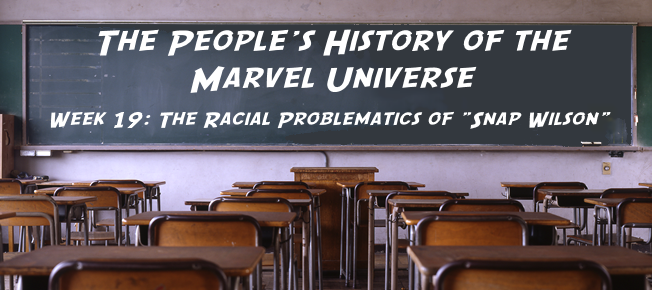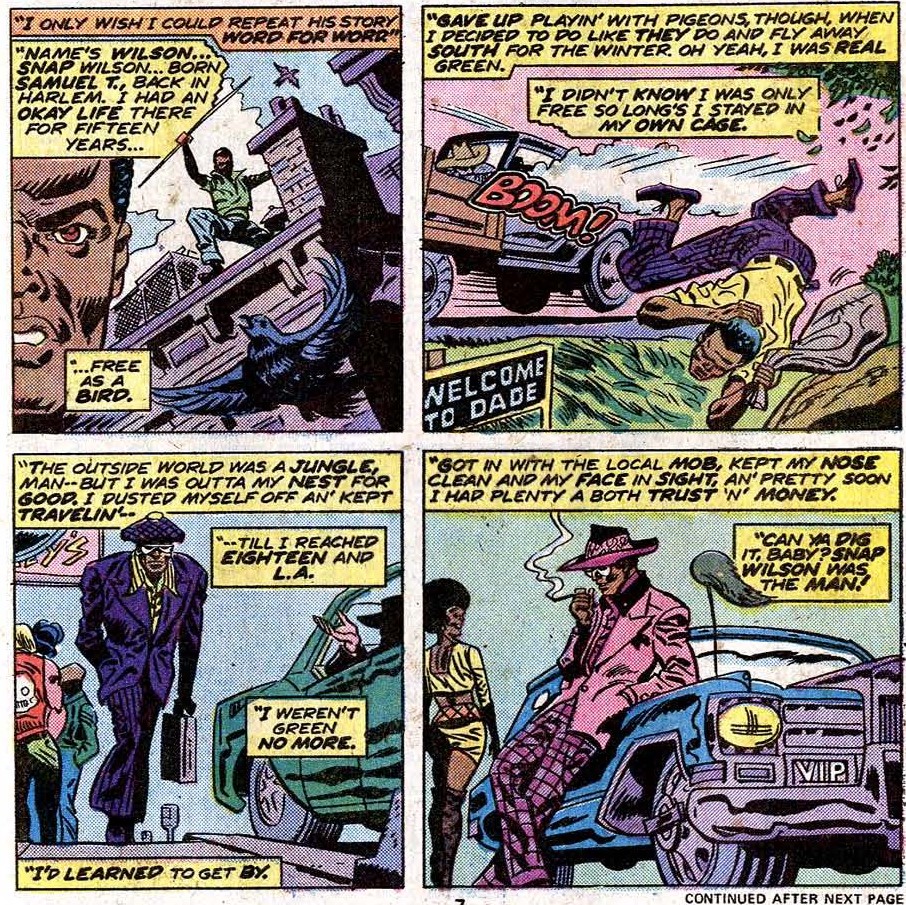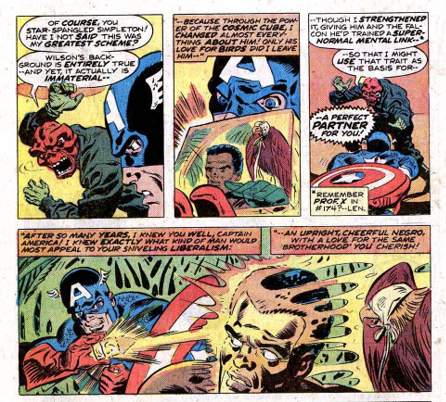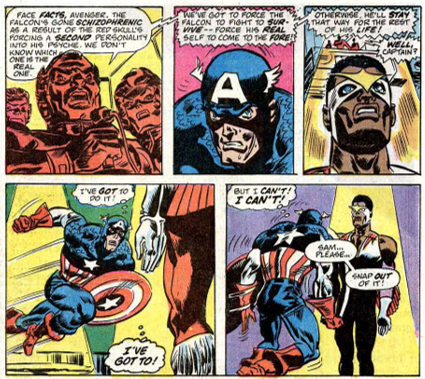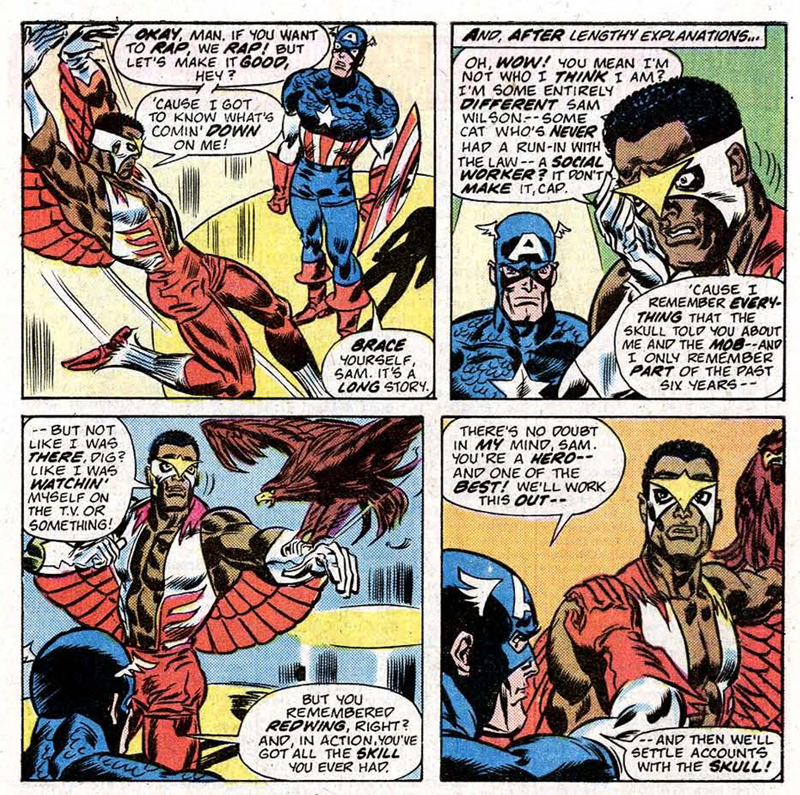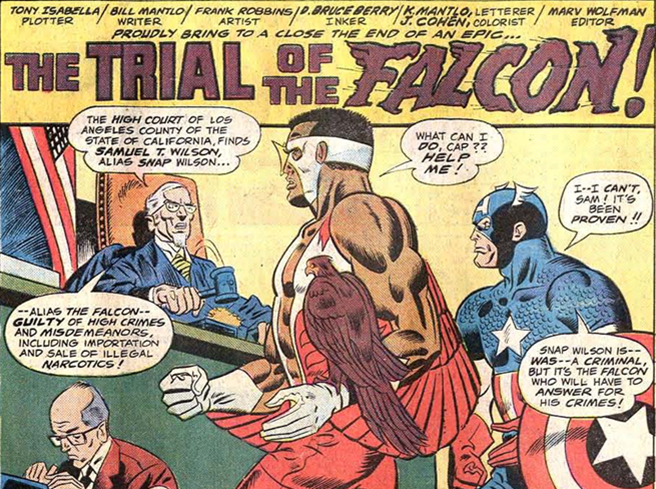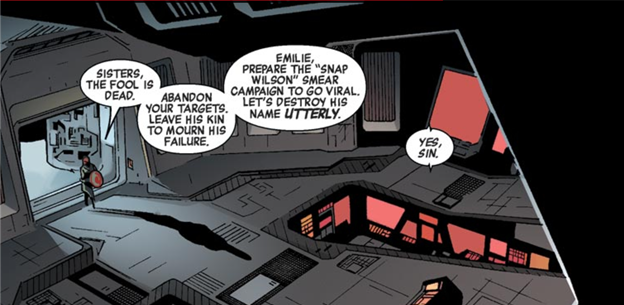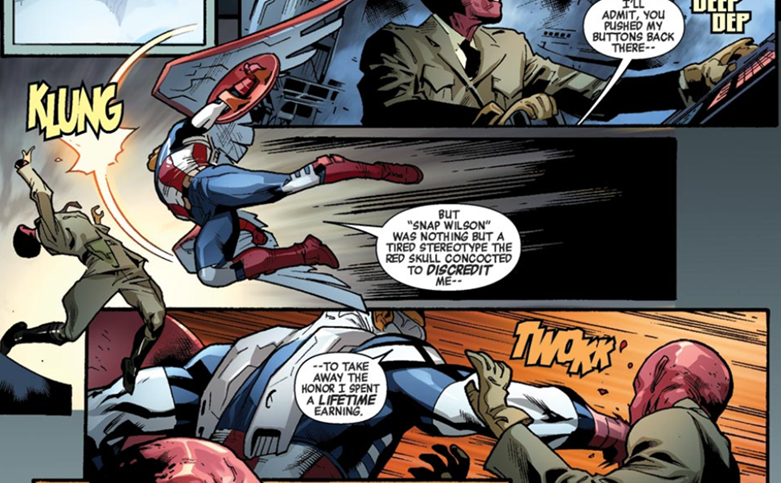People’s History of the Marvel Universe, Week 19: The Racial Problematics of “Snap Wilson”
As discussed last time, starting in Captain America and the Falcon #120, various Marvel writers[1] made a good deal of use out of the Falcon’s secret identity as Sam Wilson, social worker – Stan Lee used it as a vehicle for stories about youth problems, organized crime, and urban unrest (albeit ones that ended with costumed superheroes getting into punch-ups with similarly-attired supervillains), while Steve Englehart and Alan Weiss used it as a pretext to have Captain America and the Falcon investigate abuse in America’s prisons and encounter the Queen of the Werewolves.[2]
This changes in Captain America and the Falcon #186, where (in a follow-up to the original story that introduced Sam Wilson) the Red Skull reveals that everything we knew about Sam Wilson was a lie:
These four panels are worthy of some in-depth textual analysis. In the first, we see the young and innocent Sam Wilson on the rooftops of Harlem, complete with a thematic association between birds and freedom that we’ll later see embodied in his relationship with his falcon Redwing. (In future issues, this part of his backstory will be retconned to add in tragic violent crime-related deaths for both his mother and father that will inspire his vigilantism.) In the second, we see Wilson heading to Florida (like a lot of New Yorkers in the winter) only to be confronted with the specter of rural bigotry in Dade County, in a scene straight out of the shock ending of Easy Rider. By the third panel, we see that the experience has hardened our hero, and by the time that he gets to Los Angeles he’s learned to “get by” in the worlds of both street crime (as symbolized by the small crowd of black men standing on the corner) and organized crime (as symbolized by the white hand coming out of the car window). In the fourth panel, the transformation of Sam Wilson into “Snap” Wilson is complete – he’s now an L.A-based gangster complete with mob connections, a pimped-out Cadillac with vanity license plates, and some of the 70’s wildest fashions.
As we learn about on the next page, rather than arriving on the island of forbidden love as part of a vacation-turned-resistance-movement, “Snap” Wilson crash-landed on the island after attempting to hijack a small plane containing a “fortune” (presumably of drugs, given that the plane was returning from a trip to Latin America) belonging to the “Big Man,” his L.A-based crime boss.
More significantly, we learn that the social Sam Wilson that readers thought they knew was a creation of the Red Skull, a fiction specifically designed to appeal to Steve Rogers’ liberal values:
Steve Englehart, John Warner, and Frank Robbins had to lean heavily on the Cosmic Cube’s, well…cosmic powers here, because this is quite a retcon. Above and beyond the psychological impact on Wilson himself, the creative team had to explain how it was that we’ve seen Sam Wilson at work as a social worker – we’ve even seen his office with clients in it! – and it would be particularly odd for the Cube to somehow have also altered the memories of the entire “Social Admin” Department of New York City so that someone without official hiring paperwork or credentials would be given office space, a salary, and a caseload for several years.
This being a superhero comic, the retcon is then used by the Red Skull (once again using mind control) to pit the Falcon against Captain America in a lose-lose fight to the death. Naturally, Captain America triumphs and destroys the Red Skull’s HYDRA base, only for the Skull himself to flee to fight another day. Rather than resolving neatly in one issue like earlier “Cap goes evil” storylines, the dangling plot thread of “Snap” Wilson and the dueling backstories continues to dominate the book for the next several issues.
For example, in Captain America and the Falcon #189, Tony Isabella and Frank Robbins have Captain America once more fight Sam Wilson in a dubious SHIELD experiment to prove which is the real personality.
After a bunch of illusionary shenanigans, the Falcon snaps out of his “schizophrenic” state to reveal that, in fact, it is “Snap” Wilson who was the true personality and Sam Wilson who was the fake.
Tony Isabella, Bill Mantlo, and Frank Robbins would return to (and in their own words “bring to a close the end of an epic”) plot in issue #191, in which “Snap” Wilson is put on trial in Los Angeles County Court for the “importation and sale of illegal narcotics”:
The Falcon is only saved from prison when, in a bid to prevent him from turning state’s witness against his former mob associates, the “Big Man” of Los Angeles hires, of all the many Marvel villains-for-hire, the Stilt-Man to attack the courthouse and assassinate the Falcon before he can testify. As one might guess, the ensuing action allows the Falcon to demonstrate his heroism to the judge, leading to a suspended sentence of parole (with Nick Fury of SHIELD standing in as his parole officer), thus demonstrating the fairness and mercy of the American court system when dealing with black defendants up on drugs charges in the first wave of Nixon’s War on Drugs.
The racial politics of this retcon are bizarre to say the least. The new “Snap” Wilson behaves like a quite different character than the one readers had known for sixty-nine issues: he’s more aggressive and violent both in interpersonal communication and combat, he uses stereotypical “jive” slang, and he’s far more cynical about white America and white institutions – an interesting departure for a character previously given to attempts at “cooling down” racial tensions. One could see it as an extrapolation of the “talker” versus “fighter” dynamic between Sam Wilson, social worker, and the vigilante known as the Falcon, if not for the charged nature of “Snap” Wilson’s gangster origin.
Two potential explanations for this change suggest themselves. The first is that we need to see this in the context of Marvel chasing the trend of blaxploitation, more prominently seen in the creation of the characters Luke Cage and Blade at around the same time. A streetwise gangster simply fits into the rather narrow schema of the blaxploitation genre better than a social worker out of a prestige “problem” film. However, Captain America and the Falcon was an established comic rather than a newer, more speculative venture like Power Man, and more importantly it was the comic of their flagship “flag suit” character, which tends to come with higher visibility and tighter editorial control within the company.
The second explanation, and one that has a certain amount of plausibility given that Cap #186 was authored by noted liberal Steve Englehart (just coming off of having Captain America go up against Richard Nixon), is that the retcon was prompted by a weird white liberal guilt trip that judo-flipped its way into being accidentally racist. Sam Wilson, as originally envisioned by Stan Lee, was an “articulate,” clean-cut, politically moderate black professional. It may have been argued at the time that the character of the Falcon was a paternalistically condescending bit of outreach to the black community from a bunch of white middle aged middle class folks at Marvel. By contrast, a more “street” character, as we’ve already said more evocative of popular trends in black culture, who challenges the white establishment more consistently than before, may have been seen as a more “authentic” portrait of black masculinity in the 1970s. If so, it’s a very strange train of thought where an attempt to be racially sensitive boomerangs back around to being back-handedly racist.
The problem with this line of political logic is the question of representation. There’s nothing inherently wrong with an individual character having a backstory of coming from the “mean streets” of crime, but when you’re dealing with a situation in which there are very few characters of color in Marvel comics (especially back in the 1970s when the main struggle within Marvel was over introducing racial “firsts”), aspects of those characters become less individualized and more archetypal. When most if not all of Marvel’s black characters at the time came from “the street,” it starts to send a message that, according to Marvel creative and editorial (again, staffed almost entirely by white men), the “street” is where black characters come from. This becomes problematic when it means that having a black character with a different background – like, for example, a professional social worker – is seen as less “realistic” than an ex-hood.
So much for the “epic” of “Snap” Wilson. I know there are going to be some in the fandom who will say that, given the realities of a serial medium produced monthly over the course of almost fifty years by a variety of creative and editorial teams of varying levels of ability and care for the material, you’re going to get some bad stories worked in there. These stories – if left unchecked – can warp characters out of being usable recurring intellectual property, which is why retcons aren’t always a bad thing because they can right a sinking ship in the wake of a particularly ill-thought-out or poorly executed creative turn.
This is why, when we talk about the impact of a given story in comics, we can’t just talk about the aesthetic merit of a given panel or page or comic, but its longevity – did a given story have an enduring impression on the book and the larger Marvel Universe, or was it a flash in the pan that was swiftly cleaned up by the next team to work on the book?
The answer to that question is why the “Snap” Wilson retcon is such a big deal: it lasted for forty years, putting it up there as one of the longest-lasting retcons in Marvel history. It was the status quo when Steve Englehart left the book, it was the status quo when Jack Kirby returned to both write and draw the book (more on that in a future issue), it was the status quo for Mark Gruenwald’s classic run in the 80s, and it was the status quo for Ed Brubaker’s run that set the terms for the MCU Captain America films.
It wouldn’t change until 2015, when as part of the Avengers NOW! event[3] Sam Wilson was promoted to the role of Captain America for the first time (although not the first time that he’d worn the uniform) – a creative and editorial decision that would ultimately give rise to the Disney+ Falcon and Winter Soldier show. In All-New Captain America #3, intending to discredit as well as kill the new Captain America, Sin (the Red Skull’s daughter) and HYDRA engages in information warfare by releasing to the public the sordid details of “Snap” Wilson’s past:
To a significant extent, Remender designs All-New Captain America #3 to be in dialogue with Englehart’s Captain America and the Falcon #186 – no less than three pages out of the book are devoted to a beat-for-beat reproduction of the story of the Red Skull using the Cosmic Cube to re-write Sam Wilson’s backstory, for example. The major difference is that, rather than staying in a mind-controlled silent stupor while Steve Rogers plays the interlocutor to the Red Skull, here Sam Wilson is allowed to speak and he challenges Sin’s characterization of his past as a “liar, thug, and gangster” as “lies.” (Remender does his own editorializing by characterizing the “Snap Wilson” backstory as a “smear campaign” and presenting Sin as clearly an unreliable narrator given to monologuing about the victors rewriting history to suit their interests.)
In foiling both Sin’s smear campaign and (somewhat more importantly) her bomb plot, Sam Wilson defiantly asserts a brand-new status quo for his own backstory:
While Rick Remender is a writer whose politics I haven’t always agreed with – only two years before this issue, Remender had written Uncanny Avengers #5, which featured the now-infamous “M word” speech, and then reacted extremely poorly to criticism over how this speech handled the topic of minority identities and the mutant metaphor – I think he was on the right track in this case.
As I’ve suggested above in discussing the question of representation, “ex-gangster from the mean streets” was already something of a “tired stereotype” back in 1975, and it was only more of one in 2015 when you consider the increase in the raw numbers of African-American characters in big two comics, given how many of those new characters had been given “street” backgrounds themselves. By contrast, there is something innovative about a social worker backstory not just from the perspective of African-American characters but superheroes in general: whereas most heroes with secret identities are cops, private detectives, reporters (because those professions involve being “nosy” and thus lend themselves to story hooks involving investigations), or scientists (which lends itself to super-science story hooks), there really aren’t that many heroes who belong to one of the “caring” professions. As we discussed back in Week 18, social workers have a unique perspective on social phenomena, while still giving rise to sixty issues worth of story hooks.
Ultimately, however, the question of whether a given character’s backstory is innovative or stereotypical is rather subjective. Which is why the subjectivity of the creative and editorial teams matters – and why it mattered that for so long that the teams working on Captain America and the Falcon were all-white (as well-meaning as they might have been). Had there been more diversity in the room at the time, black creators might have been able to push back on the “Snap” Wilson retcon from the beginning instead of having to wait forty years for a white creator to decide it wasn’t all right.
[1] Between Cap #120 and #186, there wasn’t a regular artist on the book on issues covering Sam Wilson as a social worker: artists ranged from Gene Colan on #120 and 134 to John Romita Sr. on #139 to Sal Buscema on #149 to Alan Weiss and John Romita Sr. on #164.
[2] A story notable for being the first but by no means the last time that CapWolf became a part of Marvel Comics. More on that in a future issue of People’s History of the Marvel Universe.
[3] Itself a continuation of the All-New Marvel NOW! event from 2013, which itself was a continuation of Marvel NOW! from 2012, but which shouldn’t be confused with All-New, All-Different Marvel which would launch later in 2015, eventually giving rise to the Secret Empire event. Needless to say, Marvel editorial hasn’t exactly made things easier for comics historians in their naming conventions in recent years.



